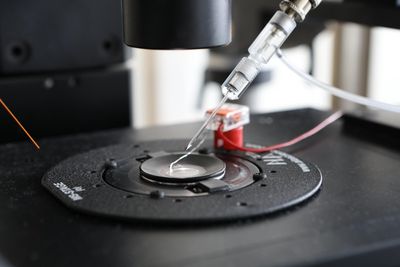Patch-clamp technique
The patch-clamp technique is a highly sophisticated electrophysiological method used to study whole-cell or single-channel currents in individually isolated living cells. Patch-clamp recordings are obtained by electrically isolating a region of membrane using an electrolyte-filled glass capillary attached to the cell membrane. A mild suction is applied to rupture the membrane patch, thus providing access through the pipette to the intracellular space of the cell. A silver chloride electrode inserted at the end of the capillary provides electrical continuity with a reference electrode placed in the extracellular bath solution. It is considered the “gold standard” for ion channel measurements and it can be used e.g. to study the effect of a treatment (e.g. drug) on living cells.
A high-end patch-clamp setup is used at our Institute to study calcium-activated BEST1 chloride currents in treated and untreated retinal pigment epithelium (RPE) cells differentiated from patient-derived induced pluripotent stem cell lines.

